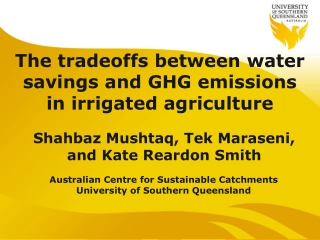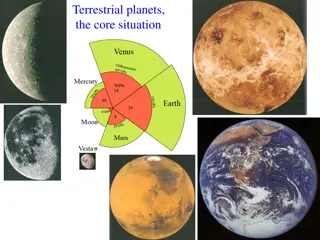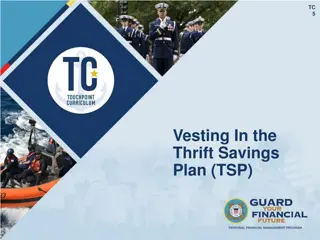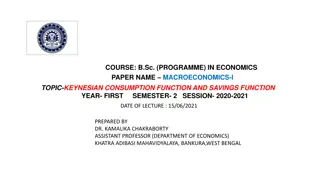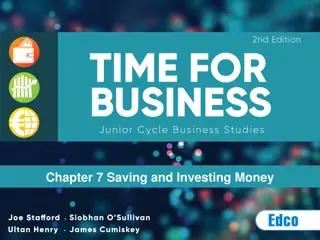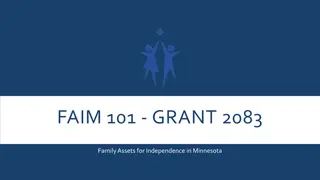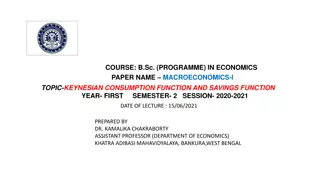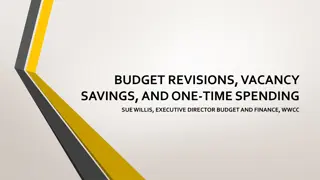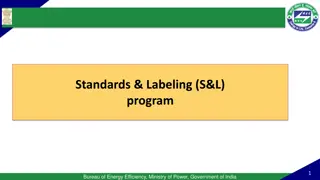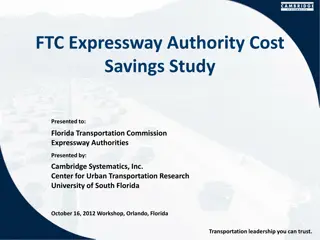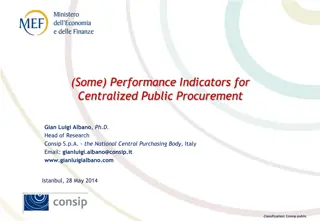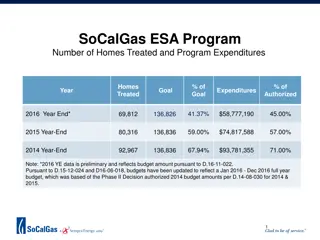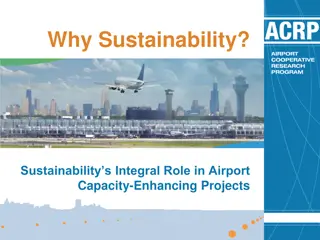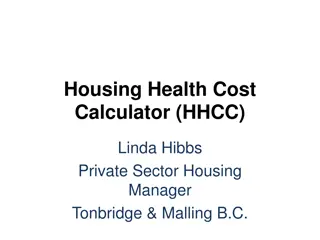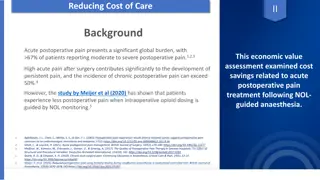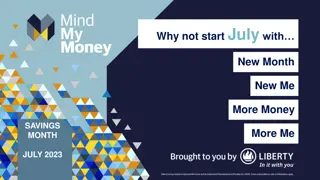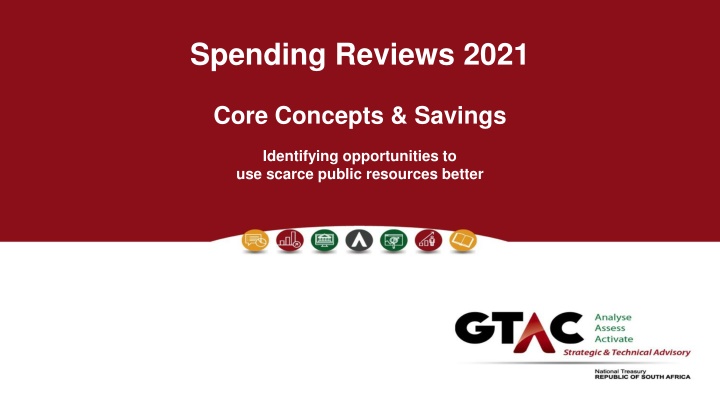
Spending Reviews, Savings, and Efficiency in Public Resource Management
Explore the core concepts of spending reviews in 2021, including the importance of identifying opportunities to use scarce public resources more effectively. Learn about the significance of savings, the difference between savings and expenditure cuts, and the impact of budget cuts on service quality in various sectors.
Download Presentation

Please find below an Image/Link to download the presentation.
The content on the website is provided AS IS for your information and personal use only. It may not be sold, licensed, or shared on other websites without obtaining consent from the author. If you encounter any issues during the download, it is possible that the publisher has removed the file from their server.
You are allowed to download the files provided on this website for personal or commercial use, subject to the condition that they are used lawfully. All files are the property of their respective owners.
The content on the website is provided AS IS for your information and personal use only. It may not be sold, licensed, or shared on other websites without obtaining consent from the author.
E N D
Presentation Transcript
Spending Reviews 2021 Core Concepts & Savings Identifying opportunities to use scarce public resources better
Why SRs matter. SRs ARE GENERALLY UNDERTAKEN PRIMARILY TO FIND SAVINGS. Often they are targeted at programmes that someone in a treasury or a policy-making position believes is not delivering value for money. SRs ARE NOT JUST ABOUT IMPROVING SPENDING PERFORMANCE Can seek to test whether a programme is worth having at all or if it could be cut/scaled back without undue harm. Sometimes a programme can be fixed and can be made to deliver VFM. Sometimes they cannot 3
Savings vs Expenditure Cuts What do we mean by savings ? How does it relate to the idea of waste? What is the difference between Savings Cuts Underspending Why are savings important? 4
PFMA definition Waste Useful as an accounting definition, not incorrect But, waste also expenditure that is fully authorised, properly planned (and survived audit!) but achieved nothing Savings can only be found when there is waste in non-PFMA sense 5
Think of how across the board cuts in budget might impact on the quality of services in different sectors Cuts Unplanned cuts in education will result in increasing pupil:teacher ratios decline in the choice of subjects offered at schools deteriorating maintenance of infrastructure cutting expenditure on library books, art materials and computers To avoid unintended consequences or general reduction in services, cuts must: target specific inputs, activities or programmes be the product of deliberate changes in how things are done result from an informed set of trade-offs or priority choices 6
What do we mean by savings? Spending less to achieve the same result Spending the same amount to achieve more Savings are often possible because of waste Savings What do we not mean by savings? Cutting expenditure on a programme Underspending on a programme i.e. allocated funds, but lack institutional capacity to spend it 7
Cash savings When budgeted funds are released in the forward estimates to be reallocated to other priorities or to reduce overall spending To count as a saving, this must be without reducing benefits of programme Cash is released for other activities or to reduce total spending Non-cash savings When the quantity and/or quality of programme outputs are increased at no additional expense result of operational efficiencies improved economy in the cost of inputs through better pricing, input substitution new technologies Cash versus non-cash savings 8
Cuts that are not properly planned and managed invariably result in decreasing service quality Cuts must result from deliberate management action and not chance 9
Allocative efficiency Why are savings important? To increase effectiveness and efficiency To reduce spending in one place in order to increase spending elsewhere To reduce spending because existing levels are unaffordable 10
Work in groups Waste, cuts and savings in WCG Instructions Think of one example of a recent attempt to cut spending in WCG. How easily was it implemented? What problems were encountered? Did it actually save money? Were there any other impacts? Ten minutes 11
Work in groups Waste, cuts and savings in DoE Instructions Instruction from MEC: we need to cut DoE spending by 10% over three years 80% of spending is compensation Question You must cut spending while minimizing the effect on the quality of teaching out comes. How will you do this? Assume that you have a free-hand: anything you propose can be done Time 10 Minutes 12
The overall aim is to improve allocative efficiency and operational efficiency so as to ensure the cost effective use of resources 13
Resources are limited, needs and wants are unlimited Adapted from:Microeconomicsby Ralph T. Burns and Gerald M. Stone, Harper Collins, New York 1993, pp. 210- 212 14
Scarcity, budgets, costing and savings Fiscal policy aims to foster economic growth Government budget processes seek to manage scarcity A sound budget process starts with a resource constraint, which is top-down It then allocates the limited funds to spending proposals Based on their relative priority allocative efficiency Bottom-up approach of assessing spending needs What are the social or economic development needs and how can government meet them? Needs often far exceed available fiscal resources The search for savings and trade-offs is necessary to ensure policy is fiscally affordable and sustainable 15
SAG debt and debt:GDP R6,000,000 100% 90% R5,000,000 80% 70% R4,000,000 60% R millions R3,000,000 50% 40% R2,000,000 30% 20% R1,000,000 10% R0 0% Gross loan debt (LHS) Debt:GDP (RHS) 16
Govt revenue and spending since 2000 R2,500,000 R2,000,000 R1,500,000 R millions R1,000,000 R500,000 R0 Revenue Spending 17
What drives public spending? Constitutional commitments and functions of state State as provider of public goods/services and social welfare Immediate rights basic education, social welfare of children Progressive realisation of rights housing, healthcare, food security, higher education Other essential functions of government police, courts, military, diplomacy, Treasuries, SARS, DHA, Statutory commitments Provisions of law that give effect to above or impose other obligations on govt to spend money Other commitments Sate as employer, esp irt remuneration, pay progression: contractual commitments to employees relating to remuneration and other HR policies State as a borrower: debts must be repaid State as a driver of social and economic development Provider of infrastructure Industrial policy support 18
Deciding between competing priorities: theory Core insight of theory of public finance Governments should not spend money on A if they can do more for society by spending that money on B Unless the last rand spent on each activity produces the same amount of social benefit, society s best interests can be advanced by moving money from one function to another The law of diminishing marginal return The value of a glass of water depends on how much water you already have! The same is true for allocations to departments and programmes. 19
Deciding between competing priorities: theory The problem is that it is impossible to compare the social good produced by spending on different public functions How do you compare the social good of policing, basic education, industrial policy, nursing, social welfare, diplomacy The goods produced are very different They benefits are enjoyed by different categories of people It is, in any case, very hard to quantify all the benefits (and costs) of particular goods/services. Constitutional principles & statutory priorities should shape the choices. In practice this is very difficult. 20
Deciding between competing priorities: in practice What really determines spending priorities? Inertia: the mix of things we do today looks a lot like the mix of things we did before Resistance to change by beneficiaries of current spending is often stronger than those who favour change Resistors Beneficiaries of existing policies Existing units/staff/management don t want to lose jobs or be redeployed Politically powerful interest groups Suppliers who have favourable contracts Proponents of change Those who want to increase their budgets and the beneficiaries of those agencies Tax-payers (who might want to see less spending) 21
Deciding between competing priorities: considerations other than power It is not a good thing that the power of incumbents shapes spending so much Public officials, collectively, need to give expression to the vision of society contained in the constitution Need to find ways to allocate scarce public resources optimally, even though it is hard How? Take seriously the commitments to enhancing the dignity of, and service delivery to, the poor and vulnerable Do as much as possible of the things that matter most and as little as possible of the things that matter least Try to do things as efficiently as possible and minimise waste and inefficiency Hold people accountable for how they use resources for which they are responsible 22
Final thoughts The costs and benefits of public goods services are not always obvious There is a cost associated with ensuring accountable governance the cost of representative institutions and accountability mechanisms the cost of structures and processes required to implement the PFMA, the MFMA the policy requirements linked to performance management Beware of recommending savings for government that shift costs onto other role-players or onto future generations E.g. saving on infrastructure maintenance spending? 23
GTAC Government Technical Advisory Centre Private Bag X115 Pretoria 0001 GTAC Government Technical Advisory Centre 240 Madiba Street Pretoria 0002 info@gtac.gov.za www.gtac.gov.za 24

